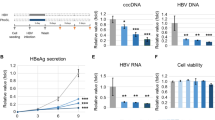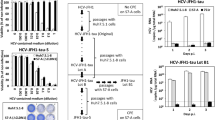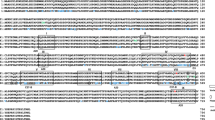Abstract
To improve the utility of herpes simplex virus type 1 (HSV-1) vectors for gene therapy, the viral envelope needs to be manipulated to achieve cell-specific gene delivery. In this report, we have engineered an HSV-1 mutant virus, KgBpK− gC−, deleted for the glycoprotein C (gC) and the heparan sulfate-binding domain (pK) of gB, in order to express gC:preS1 and gC:preS1 active peptide (preS1ap) fusion molecules. PreS1, and a 27 amino acid active peptide inside preS1 (preS1ap), are supposed to be the molecules that the human hepatitis B virus (HBV) needs to bind specifically to hepatocytes. Biochemical analysis demonstrated that the gC:preS1ap fusion molecule was expressed and incorporated into the envelope of the recombinant HSV-1 virus KgBpK−gC:preS1ap. Moreover, KgBpK−gC:preS1ap recombinant virus gained a specific binding activity to an hepatoblastoma cell line (HepG2) with a consequent productive infection. In addition, anti-preS1-specific antibodies were shown to neutralize recombinant virus infectivity, and a synthetic preS1ap peptide was able to elute KgBpK−gC:preS1ap virus bound on HpeG2 cells. These data provide further evidence that HSV-1 can productively infect cells through a specific binding to a non-HSV-1 receptor. Furthermore, these data strongly support the hypothesis that the HBV preS1ap molecule is an HBV ligand to hepatocytes.
This is a preview of subscription content, access via your institution
Access options
Subscribe to this journal
Receive 12 print issues and online access
$259.00 per year
only $21.58 per issue
Buy this article
- Purchase on Springer Link
- Instant access to full article PDF
Prices may be subject to local taxes which are calculated during checkout







Similar content being viewed by others
References
Kay MA, Glorioso JC, Naldini L . Viral vectors for gene therapy: the art of turning infectious agents into vehicles of therapeutics. Nat Med 2001; 7: 33–40.
Kootstra NA, Verma IM . Gene therapy with viral vectors. Annu Rev Pharmacol Toxicol 2003; 43: 413–439.
Lundstrom K . Latest development in viral vectors for gene therapy. Trends Biotechnol 2003; 21: 117–122.
Mah C, Byrne BJ, Flotte TR . Virus-based gene delivery systems. Clin Pharmacokinet 2002; 41: 901–911.
Robbins PD, Tahara H, Ghivizzani SC . Viral vectors for gene therapy. Trends Biotechnol 1998; 16: 35–40.
Advani SJ, Weichselbaum RR, Whitley RJ, Roizman B . Friendly fire: redirecting herpes simplex virus-1 for therapeutic applications. Clin Microbiol Infect 2002; 8: 551–563.
Anderson DB et al. Pseudotyping of glycoprotein D-deficient herpes simplex virus type 1 with vesicular stomatitis virus glycoprotein G enables mutant virus attachment and entry. J Virol 2000; 74: 2481–2487.
Burton EA, Bai Q, Goins WF, Glorioso JC . Targeting gene expression using HSV vectors. Adv Drug Deliv Rev 2001; 53: 155–170.
Douglas JT . Targeted gene delivery by tropism-modified adenoviral vectors. Nat Biotechnol 1996; 14: 1574–1578.
Han X, Kasahara N, Kan YW . Ligand-directed retroviral targeting of human breast cancer cells. Proc Natl Acad Sci USA 1995; 92: 9747–9751.
Laquerre S, Anderson DB, Stolz DB, Glorioso JC . Recombinant herpes simplex virus type 1 engineered for targeted binding to erythropoietin receptor-bearing cells. J Virol 1998; 72: 9683–9697.
Nicklin SA, Baker AH . Tropism-modified adenoviral and adeno-associated viral vectors for gene therapy. Curr Gene Ther 2002; 2: 273–293.
Valsesia-Wittmann S et al. Modification in the binding domain of avian retrovirus envelope protein to redirect the host range of retroviral vectors. J Virol 1994; 68: 4609–4619.
Aw MM, Dhawan A . Acute liver failure. Indian J Pediatr 2002; 69: 87–91.
Clayton PT . Inborn errors presenting with liver dysfunction. Semin Neonatol 2002; 7: 49–63.
Stecenko AA, Brigham KL . Gene therapy progress and prospects: alpha-1 antitrypsin. Gene Therapy 2003; 10: 95–99.
Kobayashi S et al. Gene transfer into the liver by plasmid injection into the portal vein combined with electroporation. J Gene Med 2003; 5: 201–208.
Cheung ST et al. Liver as an ideal target for gene therapy: expression of CTLA4Ig by retroviral gene transfer. J Gastroenterol Hepatol 2002; 17: 1008–1014.
Ferry N, Heard JM . Liver-directed gene transfer vectors. Hum Gene Ther 1998; 9: 1975–1981.
Fong Y et al. Rapid and efficient gene transfer in human hepatocytes by herpes viral vectors. Hepatology 1995; 22: 723–729.
Forbes SJ et al. Retroviral gene transfer to the liver in vivo during tri-iodothyronine inducing hyperplasia. Gene Therapy 1998; 5: 552–555.
Fraefel C et al. Gene transfer into hepatocytes mediated by helper virus-free HSV/AAV hybrid vectors. Mol Med 1997; 3: 813–825.
Guha C, Roy-Chowdhury N, Jauregui H, Roy-Chowdhury J . Hepatocyte-based gene therapy. J Hepatobiliary Pancreat Surg 2001; 8: 51–57.
Gupta S, Malhi H, Gagandeep S, Novikoff P . Liver repopulation with hepatocyte transplantation: new avenues for gene and cell therapy. J Gene Med 1999; 1: 386–392.
Ido A et al. Gene therapy targeting for hepatocellular carcinoma: selective and enhanced suicide gene expression regulated by o hypoxia-inducible enhancer linked to a human á-fetoprotein promoter. Cancer Res 2001; 61: 3016–3021.
Jarnagin WR et al. Neoadjuvant treatment of hepatic malignancy: an oncolytic herpes simplex virus expressing IL-12 effectively treats the parent tumor and protects against recurrence-after resection. Cancer Gene Ther 2003; 10: 215–223.
Kosai KI et al. Retrovirus-mediated in vivo gene transfer in the replicating liver using recombinant hepatocyte growth factor without liver injury or partial hepatectomy. Hum Gene Ther 1998; 9: 1293–1301.
Kren BT, Chowdhury NR, Chowdhury JR, Steer CJ . Gene therapy as an alternative to liver transplantation. Liver Transplant 2002; 8: 1098–1108.
Lu B, Gupta S, Federoff H . Ex vivo hepatic gene transfer in mouse using a defective herpes simplex virus-1 vector. Hepatology 1995; 21: 752–759.
Pichard V, Aubert D, Ferry N . Efficient retroviral gene transfer to the liver in vivo using nonpolypeptidic mitogens. Biochem Biophys Res Commun 2001; 286: 929–935.
Fraefel C, Jacoby DR, Breakefield XO . Herpes simplex virus type 1-based amplicon vector systems. Adv Virus Res 2000; 55: 425–451.
Glorioso JC et al. Engineering herpes simplex virus vectors for human gene therapy. Adv Pharmacol 1997; 40: 103–136.
Latchman DS . Gene delivery and gene therapy with herpes simplex virus-based vectors. Gene 2001; 264: 1–9.
Link CJ, Vahanian NN, Wang S . Herpes simplex amplicon vectors. Methods Mol Med 2003; 76: 61–87.
Burton EA, Bai Q, Goins WF, Glorioso JC . Replication-defective genomic herpes simplex vectors: design and production. Curr Opin Biotechnol 2002; 13: 424–428.
Krisky DM et al. Development of herpes simplex virus replication-defective multigene vectors for combination gene therapy applications. Gene Therapy 1998; 5: 1517–1530.
Krisky DM et al. Deletion of multiple immediate-early genes from herpes simplex virus reduces cytotoxicity and permits long-term gene expression in neurons. Gene Therapy 1998; 5: 1593–1603.
Chung SM et al. The use of a genetically engineered herpes simplex virus (R7020) with ionizing radiation for experimental hepatoma. Gene Therapy 2002; 9: 75–80.
Markovitz NS, Roizman B . Replication-competent herpes simplex viral vectors for cancer therapy. Adv Virus Res 2000; 55: 409–424.
Pawlik TM et al. Prodrug bioactivation and oncolysis of diffuse liver metastases by a herpes simplex virus 1 mutant that expresses the CYP2B1 transgene. Cancer 2002; 95: 1171–1181.
Smith ER, Chiocca EA . Oncolytic viruses as novel anticancer agents: turning one scourge against another. Expert Opin Invest Drugs 2000; 9: 311–327.
Laquerre S et al. Heparan sulfate proteoglycan binding by herpes simplex virus type 1 glycoproteins B and C, which differ in their contribution to virus attachment, penetration, and cell-to-cell spread. J Virol 1998; 72: 6119–6130.
Shukla D et al. A novel role for 3-O-sulfated heparan sulfate in herpes simplex virus 1 entry. Cell 1999; 99: 13–22.
Montgomery RI, Warner MS, Brian JL, Spear PG . Herpes simplex virus-1 entry into cells mediated by a novel member of the TNF/NGF receptor family. Cell 1996; 87: 427–436.
Krummenacher C et al. The first immunoglobulin-like domain of HveC is sufficient to bind herpes simplex virus gD with full affinity, while the third domain is involved in oligomerization of HveC. J Virol 1999; 73: 8127–8137.
Cai W, Gu B, Person S . Role of glycoprotein B of herpes simplex virus type 1 in viral entry and cell fusion. J Virol 1988; 62: 2596–2604.
Desai P, Homa FL, Person S, Glorioso JC . Excretion of non-infectious virus particles lacking glycoprotein H by a temperature-sensitive mutant of herpes simplex virus type 1: evidence that gH is essential for virion infectivity. J Virol 1988; 69: 1147–1156.
Dingwell KS et al. Herpes simplex virus glycoproteins E and I facilitate cell-to-cell spread in vivo and across junction of cultured cells. J Virol 1994; 68: 834–845.
Ligas MW, Johnson DC . A herpes simplex virus mutant in which glycoprotein D sequences are replaced by β-galactosidase sequences binds to but is unable to penetrate into cells. J Virol 1988; 62: 1486–1494.
Roop C, Hutchinson L, Johnson DC . A mutant herpes simplex virus type 1 unable to express glycoprotein L cannot enter cells, and its particles lack glycoprotein H. J Virol 1993; 67: 2285–2297.
Neurath AR, Kent SB, Strick N, Parker K . Identification and chemical synthesis of a host cell receptor binding site on hepatitis B virus. Cell 1986; 46: 429–436.
Neurath AR, Strick N . The putative cell receptor for hepatitis B virus (HBV), annexin V, and apolipoprotein H, bind to lipid components of HBV. Virology 1994; 204: 475–477.
Petit MA et al. HepG2 cell binding activities of different hepatitis B virus isolates: inhibitory effect of anti-HBs and anti-preS1 (21-47). Virology 1991; 180: 483–491.
Petit MA, Capel F, Dubanchet S, Mabit H . PreS1-specific binding proteins as potential receptors for hepatitis B virus in human hepatocytes. Virology 1992; 187: 211–222.
Fink RJ, Eisenberg RJ, Cohen GH, Wagner EK . Detailed analysis of the portion of the herpes simplex virus type 1 genome encoding glycoprotein C. J Virol 1983; 45: 634–647.
Mardberg K, Trybala E, Glorioso JC, Bergstrom T . Mutational analysis of heparan sulfate-binding domain of herpes simplex virus type 1 glycoprotein C. J Gen Virol 2001; 82: 1941–1950.
Dolter KE, King SR, Holland TC . Incorporation of CD4 into virions by recombinant herpes simplex virus. J Virol 1993; 67: 189–195.
Zhou G, Ye GJ, Debinski W, Roizman B . Engineered herpes simplex virus 1 is dependent on IL13Rα2 receptor for cell entry and independent of glycoprotein D receptor interactions. Proc Natl Acad Sci USA 2002; 99: 15124–15129.
Dutch RE, Bagai Joshi S, Lamb RA . Membrane fusion promoted by increasing surface densities of the paramyxovirus F and HN proteins: comparison of fusion reactions mediated by simian virus 5 F, human parainfluenza virus type 3 F, and influenza virus HA. J Virol 1988; 72: 7745–7753.
Takai E et al. A solid-phase enzyme immunoassay for the determination of IgM and IgG antibodies against translation products of pre-S1 and pre-S2 regions of hepatitis B virus. J Immunol Methods 1986; 95: 23–30.
Acknowledgements
We thank Joseph Glorioso for critical reading of the paper. This work was supported by the European commission (Quality of Life, QLK2-CT-1999-00055), and grants from Ministero della Sanità – National Program on AIDS (no. 40D.55) and MIUR-FIRB-2001 (RBNE0127YS_002).
Author information
Authors and Affiliations
Rights and permissions
About this article
Cite this article
Argnani, R., Boccafogli, L., Marconi, P. et al. Specific targeted binding of herpes simplex virus type 1 to hepatocytes via the human hepatitis B virus preS1 peptide. Gene Ther 11, 1087–1098 (2004). https://doi.org/10.1038/sj.gt.3302266
Received:
Accepted:
Published:
Issue Date:
DOI: https://doi.org/10.1038/sj.gt.3302266
Keywords
This article is cited by
-
Bispecific Adapter-Mediated Retargeting of a Receptor-Restricted HSV-1 Vector to CEA-Bearing Tumor Cells
Molecular Therapy (2011)
-
Targeting HSV-1 virions for specific binding to epidermal growth factor receptor-vIII-bearing tumor cells
Cancer Gene Therapy (2010)
-
A strategy for systemic delivery of the oncolytic herpes virus HSV1716: redirected tropism by antibody-binding sites incorporated on the virion surface as a glycoprotein D fusion protein
Gene Therapy (2008)
-
Advances in High-capacity Extrachromosomal Vector Technology: Episomal Maintenance, Vector Delivery, and Transgene Expression
Molecular Therapy (2008)
-
Herpes simplex virus 1 (HSV-1) for cancer treatment
Cancer Gene Therapy (2006)



